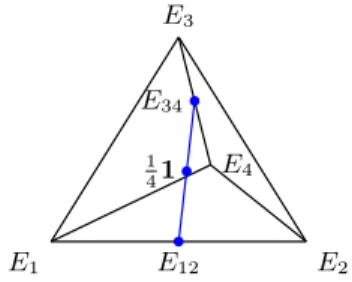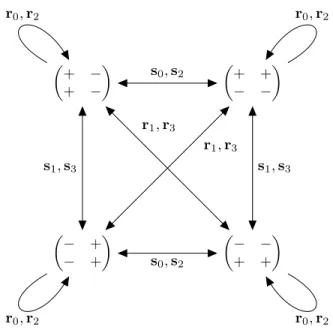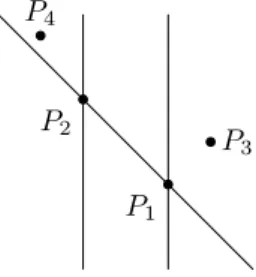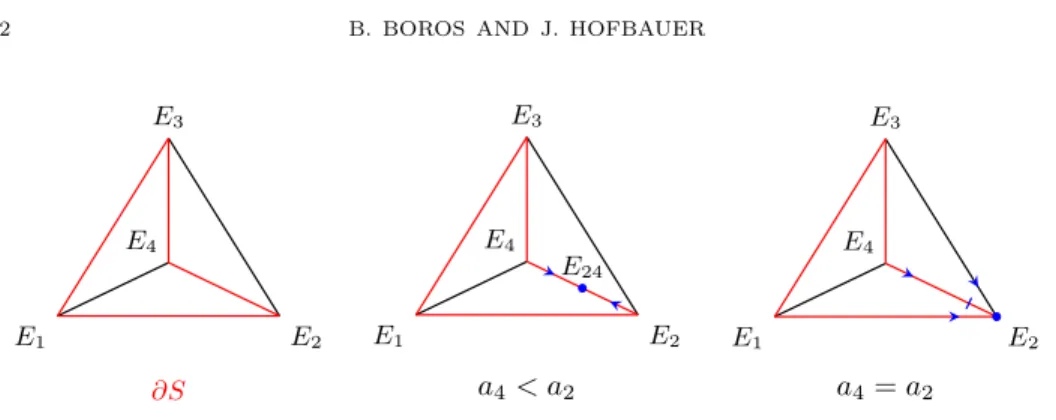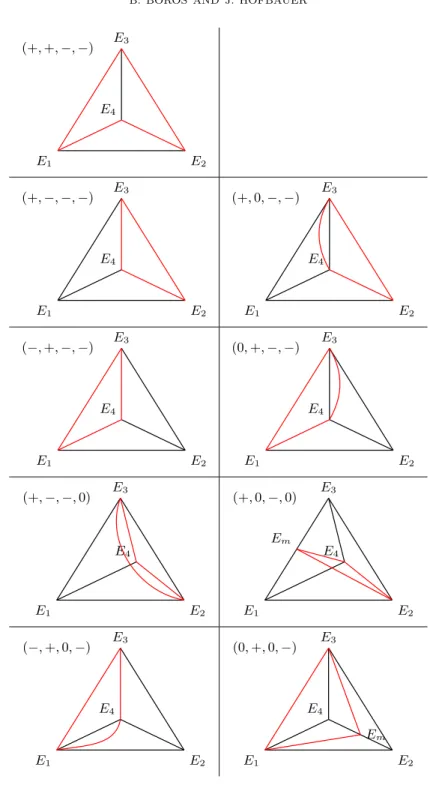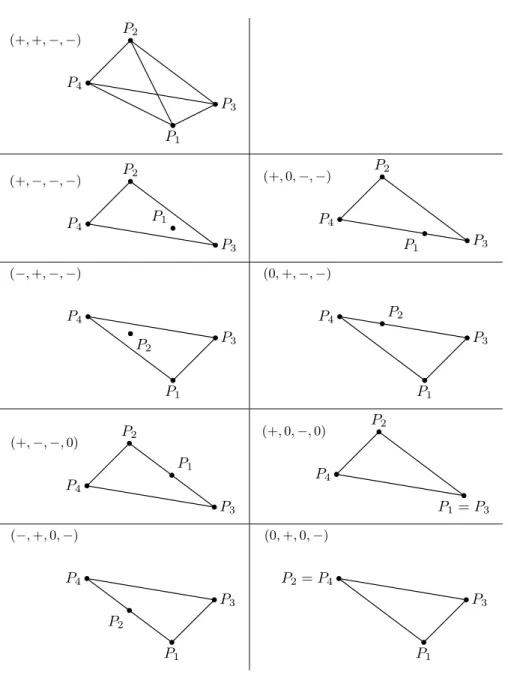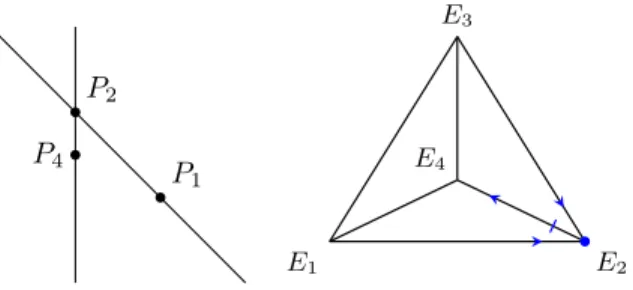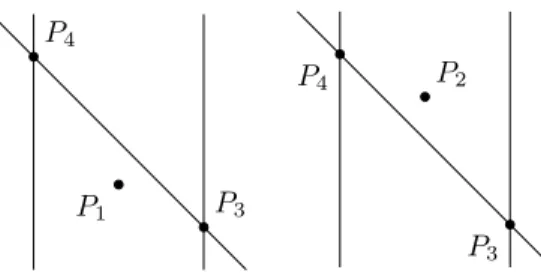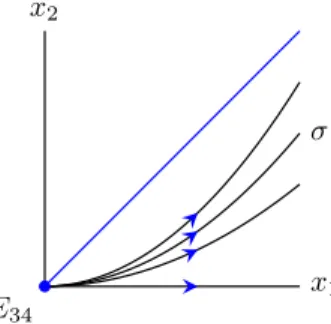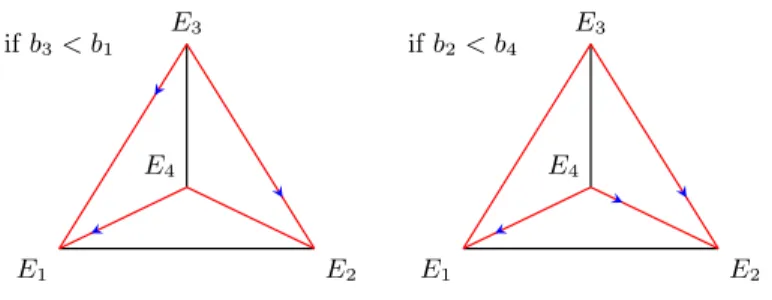arXiv:1805.10101v1 [math.DS] 25 May 2018
Bal´azs Boros and Josef Hofbauer
Faculty of Mathematics, University of Vienna Oskar-Morgenstern-Platz 1, 1090 Vienna, Austria
Abstract. We characterize permanence of planar S-systems. Further, we con- struct a planar S-system with three limit cycles.
1. Introduction. An S-system is a dynamical system on the positive orthant for which the right hand side is given by differences of power products (monomials) with real exponents. They were introduced by Savageau [11] in the context of biochemical systems theory. In a previous paper [2] we studied planar S-systems, especially the local and global asymptotic stability of the unique positive equilibrium and also the center problem.
In the present paper we characterize (except for some boundary case) the per- manence of planar S-systems. This is done by first transforming planar S-systems into a 3-dimensional replicator dynamics.
The results will be illustrated for some special cases: Selkov’s model for glycolytic oscillations [12, 4] and the Lotka reactions with generalized mass-action kinetics [6,1].
Finally, the obtained results allow us to construct a planar S-system with three limit cycles. This improves the previous studies [6] (one limit cycle) and [2,3] (two limit cycles).
2. Planar S-systems. A planar S-system is given by
˙
x1=α1xg111xg212−β1xh111xh212,
˙
x2=α2xg121xg222−β2xh121xh222 (1) withα1, α2, β1, β2 ∈R+ andg11, g12, g21, g22, h11, h12, h21, h22∈R. Since we allow real exponents, we study the dynamics on the positive quadrantR2+ ={(x1, x2)∈ R2 | x1 >0, x2>0}. Our aim in this paper is to characterize the parameters for which the ODE (1) is permanent, meaning that there exists a compact subset of R2+ that is forward invariant and is a global attractor.
A short calculation shows that there is either 0, 1, or infinitely many positive equilibria, and, if there is no positive equilibrium then the system cannot be perma- nent. We thus concentrate on the case, when there exists a (not necessarily unique)
2010Mathematics Subject Classification. 34C05, 34C11, 34C14, 34C23, 34C37, 34C45, 80A30.
Key words and phrases. Homogeneous Lotka-Volterra systems, replicator dynamics, perma- nence, heteroclinic cycle, limit cycles, center manifold, Andronov-Hopf bifurcation, Bautin bifur- cation, dihedral group.
BB is supported by the Austrian Science Fund (FWF), project P28406.
1
positive equilibrium (x∗1, x∗2). Introducing
γ1=α1(x∗1)g11−1(x∗2)g12 andγ2=α2(x∗1)g21(x∗2)g22−1, we perform the nonlinear transformation
u= 1 γ1
logx1
x∗1 andv= 1 γ2
logx2
x∗2. This leads to the ODE
˙
u= ea1u+b1v−ea2u+b2v,
˙
v= ea3u+b3v−ea4u+b4v (2)
with state spaceR2, where
a1=γ1(g11−1), b1=γ2g12, a2=γ1(h11−1), b2=γ2h12, a3=γ1g21, b3=γ2(g22−1), a4=γ1h21, b4=γ2(h22−1).
(3)
We say that the ODE (2) is permanent if there exists a compact subset ofR2 that is forward invariant and is a global attractor. Clearly, the permanence of the ODE (1) is equivalent to the permanence of the ODE (2) with (3).
The ODE (2) admits the origin as an equilibrium. The Jacobian matrixJ at the origin is given by
J =
a1−a2 b1−b2
a3−a4 b3−b4
. (4)
A short calculation shows that if detJ = 0 then the set of equilibria is either a line through the origin or the whole R2. Thus, the system cannot be permanent for detJ = 0. To characterize permanence for the ODE (1), it suffices to characterize those a1, a2, a3, a4, b1, b2, b3, b4 ∈ R, for which detJ 6= 0 and the ODE (2) is permanent. The aim of this paper is to perform this characterization (except for some boundary case). Crucial for this is the relative position of the four points Pi= (ai, bi) fori= 1,2,3,4 in the plane. Define the numbersc1,c2, c3,c4 by
c1= ∆(243), c2= ∆(134), c3= ∆(142), c4= ∆(123),
(5)
where ∆(ijk) = det(Pj−Pi, Pk−Pi) is twice the signed area of the trianglePiPjPk. The quantity ∆(ijk) is thus positive (respectively, negative) if the sequencePi,Pj, Pk, Pi of points are positively (respectively, negatively) oriented. The quantity
∆(ijk) is zero if the three pointsPi,Pj,Pk lie on a line. Note also that
∆(ijk) = ∆(jki) = ∆(kij) =−∆(jik) =−∆(ikj) =−∆(kji) andc1+c2+c3+c4= 0.
Now we show how the sign pattern ofc= (c1, c2, c3, c4) is related to the relative position of the four points P1, P2, P3, P4. There are four qualitatively different situations. (The casec= (0,0,0,0) we ignore, because then the four pointsP1,P2, P3,P4 are co-linear, contradicting detJ 6= 0.)
(i) When sgnc= (+,+,−,−), the four points P1, P2, P3,P4 form a quadrangle with diagonalsP1P2 and P3P4. The geometric interpretation of the equality
c1
2 +c22 =−c23 +−c24 is that the area of this quadrangle can be written as the sum of the areas of the trianglesP2P4P3 and P1P3P4, or alternatively as the sum of the areas of the triangles P1P2P4andP1P3P2.
(ii) When sgnc = (+,−,−,−), the three pointsP2, P3, P4 form a triangle and the point P1 lies inside. The geometric interpretation of the equality c21 =
−c2
2 +−c23+−c24 is that the area of this triangle can be written as the sum of the areas of the trianglesP1P4P3,P1P2P4,P1P3P2.
(iii) When sgnc= (+,0,−,−), the three pointsP2,P3,P4 form a triangle and the point P1 lies in the edge P3P4. The geometric interpretation of the equality
c1
2 =−c23 +−c24 is that the area of this triangle can be written as the sum of the areas of the trianglesP1P2P4,P1P3P2.
(iv) When sgnc= (+,0,−,0), the three pointsP2,P3,P4form a triangle and the point P1 coincides withP3. Clearly, c21 = −c23, because the triangles P3P2P4
andP1P2P4 coincide, and thus, their area are the same.
3. Main results. In this section we list the main results of this paper.
The following simple lemma states that permanence of the ODE (2) is possible only under detJ >0.
Lemma 3.1. If detJ ≤0then the ODE (2)is not permanent.
Proof. We discussed in Section 2 that the ODE (2) cannot be permanent under detJ = 0.
In case detJ <0, the origin is the unique equilibrium, and therefore, would the system be permanent, the index of the origin is +1, contradicting detJ <0. Thus, the system cannot be permanent under detJ <0.
The following three theorems provide an almost complete characterization of permanence of the ODE (2). The first one deals with the easier case when the diagonal entries in the Jacobian matrix at the origin are of the same sign or one of them is zero. The third one deals with the more complicated case when the diagonal entries have opposite nonzero sign. The case of a heteroclinic cycle at infinity needs a separate treatment, this is dealt with in the second of these three theorems. The proofs of the latter two are given in Sections4 and5.
Theorem 3.2. Assume that J11J22 ≥0 (i.e., (a1−a2)(b3−b4)≥0). Then the following three statements are equivalent.
(i) The ODE (2)is permanent.
(ii) The origin is globally asymptotically stable for the ODE (2).
(iii) detJ >0and one of (A), (B1), (B2) below holds.
(A) sgnJ =
− ∗
∗ −
(B1) sgnJ = 0 ∗
∗ −
andmin(a3, a4)≤a2=a1≤max(a3, a4) (B2) sgnJ =
− ∗
∗ 0
andmin(b1, b2)≤b4=b3≤max(b1, b2)
Proof. First, we prove the implication (i)⇒(iii). By Lemma3.1, permanence im- plies that detJ >0. After multiplying the vector field bye−a1u−b4v, its divergence
is
(a1−a2)e(a2−a1)u+(b2−b4)v+ (b3−b4)e(a3−a1)u+(b3−b4)v,
which is negative if at least one ofa1−a2 andb3−b4is negative, zero ifa1−a2= b3−b4 = 0, and positive if at least one of a1−a2 and b3−b4 is positive. The latter two cases cannot lead to a permanent system as the area is invariant or expanding. This leaves the three sign patterns of J given in (A), (B1), (B2). In the latter two cases, the conditions min(a3, a4) ≤ a2 = a1 ≤ max(a3, a4) and min(b1, b2)≤b4 = b3 ≤max(b1, b2) follow from the boundedness of all solutions, see [3, Lemma 5 (b2), (c2), (d2), (e2)].
The implication (iii)⇒(ii) follows from [3, Theorem 3].
Finally, the implication (ii)⇒(i) is obvious.
Theorem 3.3. Assume that detJ > 0 and further that either (A) or (B) below holds.
(A) sgnJ =
∗ −
+ ∗
and
a4≤min(a1, a2)≤max(a1, a2)≤a3
b1≤min(b3, b4)≤max(b3, b4)≤b2
(B) sgnJ =
∗ +
− ∗
and
a3≤min(a1, a2)≤max(a1, a2)≤a4
b2≤min(b3, b4)≤max(b3, b4)≤b1
In case (A), let
L∞= (a3−a1)(b2−b3)(a2−a4)(b4−b1)−(b1−b3)(a2−a3)(b4−b2)(a4−a1), while in case (B), let
L∞= (b1−b3)(a2−a3)(b4−b2)(a4−a1)−(a3−a1)(b2−b3)(a2−a4)(b4−b1).
Then the following two statements hold.
(i) IfL∞>0 then the ODE (2) is permanent.
(ii) IfL∞<0 then the ODE (2) is not permanent.
Theorem 3.4. Assume that J11J22<0 (i.e., (a1−a2)(b3−b4)<0) and at least one of the two conditions
min(a3, a4)≤min(a1, a2)≤max(a1, a2)≤max(a3, a4)and min(b1, b2)≤min(b3, b4)≤max(b3, b4)≤max(b1, b2)
is violated. Then the ODE (2) is permanent if and only if detJ > 0 and one of (C1), (C2), (C3), (C4) below holds.
(C1) sgnJ =
+ −
+ −
, a4≤a2 < a1 ≤a3, and either of (C1a), (C1b), or (C1c) below holds
(C1a) sgn(c3, c4) = (−,−)
(C1b) sgnc= (+,−,−,0) orsgnc= (−,+,0,−)and
−a1−a2
b1−b2
< (L+ 1)L+1
LL , whereL= (c
2
c3, if sgnc= (+,−,−,0),
c1
c4, if sgnc= (−,+,0,−) (C1c) sgnc= (+,0,−,0) orsgnc= (0,+,0,−)and
−a1−a2
b1−b2 ≤1 and trJ <0 (C2) sgnJ =
+ +
− −
, a3≤a2 < a1 ≤a4, and either of (C2a), (C2b), or (C2c) below holds
(C2a) sgn(c3, c4) = (−,−)
(C2b) sgnc= (−,+,−,0) orsgnc= (+,−,0,−)and a1−a2
b1−b2
< (L+ 1)L+1
LL , where L= (c1
c3, if sgnc= (−,+,−,0),
c2
c4, if sgnc= (+,−,0,−) (C2c) sgnc= (0,+,−,0) orsgnc= (+,0,0,−)and
a1−a2
b1−b2 ≤1and trJ <0 (C3) sgnJ =
− −
+ +
, b1 ≤b4 < b3 ≤b2, and either of (C3a), (C3b), or (C3c) below holds
(C3a) sgn(c1, c2) = (+,+)
(C3b) sgnc= (0,+,−,+) orsgnc= (+,0,+,−)and b3−b4
a3−a4
< (L+ 1)L+1
LL , where L= (c4
c2, if sgnc= (0,+,−,+),
c3
c1, if sgnc= (+,0,+,−) (C3c) sgnc= (0,+,−,0) orsgnc= (+,0,0,−)and
b3−b4
a3−a4 ≤1and trJ <0 (C4) sgnJ =
− +
− +
, b2 ≤b4 < b3 ≤b1, and either of (C4a), (C4b), or (C4c) below holds
(C4a) sgn(c1, c2) = (+,+)
(C4b) sgnc= (0,+,+,−)orsgnc= (+,0,−,+) and
−b3−b4
a3−a4 < (L+ 1)L+1
LL , whereL= (c3
c2, if sgnc= (0,+,+,−),
c4
c1, if sgnc= (+,0,−,+) (C4c) sgnc= (0,+,0,−)orsgnc= (+,0,−,0) and
−b3−b4
a3−a4 ≤1 and trJ <0
With Theorems3.2,3.3,3.4, permanence is characterized except in the marginal case L∞ = 0 in Theorem 3.3. The solution of this remaining case requires more sophisticated techniques.
Byrobust permanence of the ODE (2), we mean that the ODE remains perma- nent after small perturbation of the eight parametersai and bi (fori= 1,2,3,4).
The following corollary is a characterization of robust permanence, it is an imme- diate consequence of the above three theorems.
Corollary 3.5. The ODE (2) is robustly permanent if and only ifdetJ >0 and one of (A), (B1), (B2), (B3), (B4), (C1), (C2), (C3), (C4) below holds. (The numberL∞ below in (C1), (C2), (C3), (C4) is defined as in the corresponding case in Theorem3.3.)
(A) sgnJ =
− ∗
∗ −
(B1) sgnJ =
0 −
+ −
anda4< a2=a1< a3
(B2) sgnJ =
0 +
− −
anda3< a2=a1< a4
(B3) sgnJ =
− +
− 0
andb2< b4=b3< b1
(B4) sgnJ =
− −
+ 0
andb1< b4=b3< b2
(C1) sgnJ =
+ −
+ −
,a4< a2< a1< a3,sgn(c3, c4) = (−,−), and if b1< b3< b4< b2 thenL∞>0
(C2) sgnJ =
+ +
− −
,a3< a2< a1< a4,sgn(c3, c4) = (−,−), and if b2< b3< b4< b1 thenL∞>0
(C3) sgnJ =
− − + +
,b1< b4< b3< b2,sgn(c1, c2) = (+,+), and if a4< a1< a2< a3 thenL∞>0
(C4) sgnJ =
− +
− +
,b2< b4< b3< b1,sgn(c1, c2) = (+,+), and if a3< a1< a2< a4 thenL∞>0
4. From S-systems to replicator systems. To prove Theorems 3.3 and 3.4, we embed the two-dimensional ODE (2) into a four-dimensional Lotka–Volterra system. Letzi= eaiu+biv fori= 1,2,3,4. Then
˙
zi=zi[aiu˙+biv] =˙ zi[ai(z1−z2) +bi(z3−z4)] fori= 1,2,3,4, (6) which is a 4-dimensional Lotka–Volterra system with matrix
Ae=
a1 −a1 b1 −b1
a2 −a2 b2 −b2
a3 −a3 b3 −b3
a4 −a4 b4 −b4
.
Since the ODE (6) is homogeneous, we can reduce the dimension by projecting the dynamics to the 3-dimensional simplex
∆4=
x∈R4≥0|x1+x2+x3+x4= 1 . Let
xi= zi
z1+z2+z3+z4
fori= 1,2,3,4.
Then, after division by the positive factorz1+z2+z3+z4, the ODE (6) leads to
˙ xi =xi
h(Ax)e i−xTAxe i
fori= 1,2,3,4 (7)
on the simplex ∆4, the replicator equation with matrix A, see [8,e 9]. Adding any multiple of 1 = (1,1,1,1)T to any column of Ae leaves the ODE (7) unchanged, therefore, we can replace the ODE (7) by the replicator equation on the simplex ∆4
with matrix
A=
0 a2−a1 b1−b3 b4−b1
a2−a1 0 b2−b3 b4−b2
a3−a1 a2−a3 0 b4−b3
a4−a1 a2−a4 b4−b3 0
, (8)
E1 E2
E3
E4
E12
E34
1 41
Figure 1. Each point on the line segment connectingE12andE34
is an equilibrium. The planar S-system (2) and the origin of the (u, v)-plane correspond to the surfaceQ4
i=1xcii = 1 and x = 141 (the midpoint betweenE12 andE34), respectively.
i.e.,
˙ xi =xi
(Ax)i−xTAx
fori= 1,2,3,4. (9)
Note that besides the cornersE1,E2,E3,E4 of ∆4, the pointsE12= 12,12,0,0 and E34 = 0,0,12,12
are equilibria of the ODE (9). Also, each point on the line segment connecting E12 and E34 is an equilibrium. Further, a short calculation shows that detJ 6= 0 implies that there is no other equilibrium in ∆◦4, the relative interior of ∆4.
Letc∈R4 be as in (5), or explicitly,
c1=a3b2−a2b3+a2b4−a4b2+a4b3−a3b4, c2=a1b3−a3b1+a4b1−a1b4+a3b4−a4b3, c3=a2b1−a1b2+a1b4−a4b1+a4b2−a2b4, c4=a1b2−a2b1+a3b1−a1b3+a2b3−a3b2.
(10)
Note that
c1+c2= + detJ, (11)
c3+c4=−detJ (12)
and c is perpendicular to the three vectorsa, b, and1 (a short calculation shows that detJ 6= 0 implies that a, b, and 1are linearly independent). Then cTA= 0 and hence the functionQ: ∆◦4 →R+ defined byQ(x) =Q4
i=1xcii is a constant of motion for the ODE (9). Indeed, by the choice ofc,
(Q(x))·=Q(x) X4 i=1
ci
(Ax)i−xTAx
=Q(x)
"
cTAx−xTAx X4 i=1
ci
#
= 0.
The planar S-system (2) corresponds to the restriction of the ODE (9) to the surface {Q= 1}. (The origin of the (u, v)-plane is mapped toz=1andx= 141. Further, sinceP4
i=1ci= 0, we haveQ 141
= 1. See Figure1for an illustration.) The shape of the surface{Q= 1}depends on the sign pattern of c. Let
S = ∆4∩ {Q= 1}, S = ∆◦4∩ {Q= 1},
∂S =S\S.
E1 E2
E3
E4
Figure 2. Under sgnc = (+,+,−,−), the set∂S consists of the four edgesF13,F32,F24, F41.
Note that the planar S-system (2) is permanent if and only if the restriction of the ODE (9) to the surfaceS ispermanent, meaning there exists a compact subset ofS that is forward invariant and attracts every point inS (or, equivalently,∂S is a repeller in S).
We illustrate the usefulness of this embedding by proving Theorem3.3. We state and prove here case (A). Case (B) follows from case (A) by time reversal of the ODE (2), which swapsP1withP2 andP3 withP4.
Lemma 4.1. Assume that detJ >0 and further that sgnJ =
∗ −
+ ∗
and
a4≤min(a1, a2)≤max(a1, a2)≤a3
b1≤min(b3, b4)≤max(b3, b4)≤b2 . Let
L∞= (a3−a1)(b2−b3)(a2−a4)(b4−b1)−(b1−b3)(a2−a3)(b4−b2)(a4−a1).
Then the following two statements hold.
(i) IfL∞>0 then the ODE (2) is permanent.
(ii) If L∞<0 then the ODE (2)is not permanent (orbits with large initial con- ditions spiral outwards towards infinity).
Proof. First note that L∞ 6= 0 implies that all the four points P1, P2, P3, P4
are distinct. Further, the assumptions a4 ≤min(a1, a2) ≤max(a1, a2) ≤a3 and b1 ≤min(b3, b4)≤max(b3, b4)≤ b2 yield sgnc = (+,+,−,−), see (5). Then the surfaceS is given by x
|c1|
1 x|c2|2
x|c33|x|c44| = 1 and thus,∂Sconsists of the four edgesF13,F32, F24, F41, see Figure 2. There is no edge equilibrium and there is a heteroclinic cycle alongE1,E3, E2, E4,E1. Indeed, on the surfaceS, nearE4, the ODE (9) is given by
˙
x1=x1(b4−b1+f1(x1, x2)),
˙
x2=x2(b4−b2+f2(x1, x2))
with b4−b1 ≥ 0 and b4−b2 ≤ 0 (not both zero, because b1 < b2) being the eigenvalues atE4and|fi(x1, x2)| →0 as (x1, x2)→(0,0). Similarly near the other corners. By [7, Theorem 3], this heteroclinic cycle is repelling if the product of the outgoing eigenvalues is larger than the product of the incoming eigenvalues along the cycle, i.e., if
(a3−a1)(b2−b3)(a2−a4)(b4−b1)−(b1−b3)(a2−a3)(b4−b2)(a4−a1)>0.
Conversely, ifL∞<0 then the heteroclinic cycle is attracting.
5. Proof of Theorem 3.4. This section is devoted to prove Theorem 3.4. By Lemma 3.1, permanence of the ODE (2) implies detJ > 0. Since J11J22 < 0 is assumed in Theorem 3.4, all permanent systems fulfill J12J21 <0. Thus, we are left with the four sign patterns
+ −
+ −
,
+ +
− −
,
− −
+ +
,
− +
− +
for the Jacobian matrixJ. As it is explained in [3, Subsection 2.2], the family of ODEs (2) is invariant under the symmetry group of the square (i.e., the dihedral groupD4) which consists of the rotationsr0 (by 0◦),r1 (by +90◦),r2 (by +180◦), r3(by +270◦) and the reflectionss0(along theu-axis),s1(along theu=vline),s2 (along thev-axis),s3(along theu=−vline). The list in [3, Subsection 2.2] reveals how the ai and bi are mapped under these eight operations. Figure 3 illustrates how the above mentioned four sign patterns of J are transformed into each other.
The vector (c1, c2, c3, c4) is mapped by the elements of the dihedral groupD4 as (c1, c2, c3, c4)7→r0 (c1, c2, c3, c4), (c1, c2, c3, c4)7→s0 (c1, c2, c4, c3),
(c1, c2, c3, c4)7→r1 (−c4,−c3,−c1,−c2), (c1, c2, c3, c4)7→s1 (−c3,−c4,−c1,−c2), (c1, c2, c3, c4)7→r2 (c2, c1, c4, c3), (c1, c2, c3, c4)7→s2 (c2, c1, c3, c4), (c1, c2, c3, c4)7→r3 (−c3,−c4,−c2,−c1), (c1, c2, c3, c4)7→s3 (−c4,−c3,−c2,−c1).
Using these symmetries, once we prove case (C1) in Theorem 3.4, the cases (C2), (C3), and (C4) follow by applyings0or s2,r1 orr3, ands1 ors3, respectively.
Thus, from now on we mainly focus on characterizing permanence under sgnJ= + −
+ −
. Since we will make use of the rotation r2, we mention here that the ODE (2) is transformed byr2into
˙
u= e−a2u−b2v−e−a1u−b1v,
˙
v= e−a4u−b4v−e−a3u−b3v.
Further, the rotationr2 maps (P1, P2, P3, P4) to (−P2,−P1,−P4,−P3), hence, the tuple (c1, c2, c3, c4) goes to the tuple (c2, c1, c4, c3) (as already listed above).
The following lemma gives a necessary condition for the ODE (2) with sgnJ = + −
+ −
to be permanent.
Lemma 5.1. Assume that sgnJ =
+ −
+ −
and detJ >0. Then permanence of the ODE (2)implies
(i) a4≤a2< a1≤a3 and
(ii) c3≤0,c4≤0, and (c3, c4)6= (0,0).
Proof. The inequalitiesa2< a1 anda4< a3readily follow from the assumption on the sign pattern of the Jacobian matrix.
Next, we prove that a1≤a3. Assume by contradiction thata3 < a1. Then all the non-diagonal entries in the first column ofAin the ODE (9) are negative, and therefore the cornerE1= (1,0,0,0) is asymptotically stable. We claim that
there is both a positive and a negative number amongc2, c3, c4. (13)
+ +
− − + −
+ −
− +
− +
− −
+ +
s0,s2
r1,r3
s1,s3 s1,s3
r1,r3
s0,s2
r0,r2 r0,r2
r0,r2 r0,r2
Figure 3. How the elements of the dihedral groupD4 transform the sign pattern of the Jacobian matrixJ.
P1
P2
P3
P4
c3= 0, c4<0
P1
P2
P3
P4
c3<0, c4= 0
P1
P2
P3
P4
c3<0, c4<0
Figure 4. Illustration of the proof of the claim (13).
Once we show that the claim (13) indeed holds, it follows that E1 ∈ ∂S. This together with the asymptotic stability of E1 contradicts the permanence of the ODE (2). Thus,a1 ≤a3 follows. We now prove the claim (13). By equation (12), if one ofc3 and c4 is positive, the other must be negative. Observe thatc3 andc4
cannot both be zero, because then detJ = 0 by equation (12). We argue that each of sgn(c3, c4) = (0,−), sgn(c3, c4) = (−,0), and sgn(c3, c4) = (−,−) impliesc2>0.
Indeed, these follow immediately from a4 < a3 < a1 and the geometric definition (5) ofc2,c3,c4, see Figure4. The claim (13) is therefore proven.
The inequalitya4≤a2 follows in a similar way: a2< a4would imply thatE2= (0,1,0,0) is asymptotically stable (and, one can show thatE2∈∂S). Alternatively, using the rotationr2and the just proved fact that permanence impliesa1≤a3, one
P1
P2
P3
P4
Figure 5. Illustration of the proof thatc3>0 implies c1<0 andc2>0.
immediately finds that permanence implies−a2≤ −a4. Or, equivalently,a4≤a2. This concludes the proof of (i).
Assume from now on that a4 ≤ a2 < a1 ≤ a3. As we already mentioned, c3=c4= 0 would imply that detJ = 0. Thus, (c3, c4)6= (0,0).
Next, we prove that c3 ≤ 0. Assume by contradiction that c3 > 0. Then, by equation (12),c4<0. Further,c1<0 andc2>0 follow immediately, see Figure5.
Thus, sgnc = (−,+,+,−), and hence, the set ∂S is the union of the four edges F12, F24, F43, F31, see the left panel in Figure6. As can be read from Figure5, we haveb2< b4.
If a4 < a2 also holds, there exists an equilibrium E24 on the edge F24, see the middle panel in Figure6. By the equations (27) in AppendixB,
sgn Γ124=−sgnc3=−1, sgn Γ324= + sgnc1=−1,
i.e., both of the external eigenvalues atE24are negative. Thus,E24is asymptotically stable, contradicting that the flow onS is permanent.
To obtain a contradiction, it is left to show that the flow onS is not permanent whena4=a2. The eigenvalues atE2in the directionsE1,E3, andE4 are negative, negative, and zero, respectively. Further, the flow on the edgeF24goes fromE4 to E2. See the right panel in Figure6.
Therefore, the stable manifold at E2 is 2-dimensional (and is contained in the facet F123), the center manifold at E2 is 1-dimensional (and is contained in the edgeF24), and since the flow on the edgeF24goes fromE4 toE2,E2is attracting on the center manifold. By the reduction principle (see [10, Theorem 5.2]), E2
is asymptotically stable in ∆4, contradicting that the flow on S is permanent.
Therefore, we conclude that permanence impliesc3≤0.
Finally, proving that c4 is also non-positive can be done in a similar way, but it is more elegant to apply the rotationr2: it maps the tuple (c1, c2, c3, c4) to the tuple (c2, c1, c4, c3). This concludes the proof of (ii).
The following lemma reveals further connections between the signs ofc1,c2, c3, c4.
Lemma 5.2. Assume that sgnJ =
+ −
+ −
, detJ >0, and a4 ≤a2 < a1 ≤a3. Then
(i) c3= 0 andc4<0 imply c1≤0 andc2>0, (ii) c3<0 andc4= 0 imply c1>0 andc2≤0.
E1 E2
E3
E4
∂S
E1 E2
E3
E4
E24
a4< a2
E1 E2
E3
E4
a4=a2
Figure 6. Under sgnc = (−,+,+,−), the set ∂S (left panel), the asymptotically stable equilibriumE24 (middle panel), and the asymptotically stable equilibriumE2 (right panel).
P1
P2
P3
P4
Figure 7. Illustration of the proof that c3 = 0 andc4<0 imply c1≤0 andc2>0.
Proof. Underc3= 0 andc4<0, the configuration of the pointsP1,P2,P3,P4is as shown in Figure7. Using (5), one immediately obtainsc1≤0 (with equality if and only ifa2=a4 (or, equivalently,P2=P4)) andc2>0. This concludes the proof of (i).
One can prove (ii) in a similar way. Alternatively, one may apply the rotation r2, it maps the tuple (c1, c2, c3, c4) to the tuple (c2, c1, c4, c3). Thus, the statement (ii) follows from (i).
By the inequality (11) and Lemmata 5.1and5.2, there are only 9 possible sign patterns of c that a permanent ODE (2) with sgnJ =
+ −
+ −
can lead to, see Figure8. See Figure9for the relative positions of the four pointsP1,P2,P3,P4in the 9 cases.
If sgnc= (+,+,−,−) then the surface S is given by x
|c1| 1 x|c22 |
x|c33|x|c44| = 1 and thus,∂S consists of the four edgesF14,F42, F23, F31. The four pointsP1, P2, P3,P4 form a quadrangle with diagonalsP1P2 andP3P4.
If sgnc= (+,−,−,−) then the surfaceS is given by x
|c1| 1
x|c22 |x|c33 |x|c44 | = 1 and thus,
∂S consists of the three edges F23, F34, F42. The three pointsP2,P3, P4 form a triangle, andP1lies inside.
If sgnc = (+,0,−,−) then the surfaceS is given by x
|c1| 1
x|c33|x|c44|
= 1 and thus,∂S consists of the two edgesF42,F23 and the curve
C341 ={x∈∆4 |x2= 0 and x|c11|=x|c33|x|c44|} ⊆ F134,
which connectsE3 andE4. The three pointsP2,P3,P4 form a triangle, andP1lies inside the edgeP3P4.
If sgnc= (−,+,−,−) then the surfaceS is given by x
|c2| 2
x|c11 |x|c33 |x|c44 |
= 1 and thus,
∂S consists of the three edges F13, F34, F41. The three pointsP1,P3, P4 form a triangle, andP2lies inside.
If sgnc = (0,+,−,−) then the surfaceS is given by x
|c2| 2
x|c3|3 x|c4|4 = 1 and thus,∂S consists of the two edgesF41,F13 and the curve
C342 ={x∈∆4 |x1= 0 and x|c22|=x|c33|x|c44|} ⊆ F234,
which connectsE3 andE4. The three pointsP1,P3,P4 form a triangle, andP2lies inside the edgeP3P4.
If sgnc = (+,−,−,0) then the surfaceS is given by x
|c1| 1
x|c2|2 x|c3|3
= 1 and thus,∂S consists of the two edgesF34,F42 and the curve
C231 ={x∈∆4 |x4= 0 and x|c11|=x|c22|x|c33|} ⊆ F123,
which connectsE2 andE3. The three pointsP2,P3,P4 form a triangle, andP1lies inside the edgeP2P3.
If sgnc= (+,0,−,0) then the surfaceSis given byx1=x3, i.e.,Sis the triangle with verticesE2,E4,Em=12E1+12E3. The three pointsP2,P3,P4form a triangle, andP1coincides withP3.
If sgnc = (−,+,0,−) then the surfaceS is given by x
|c2| 2
x|c1|1 x|c4|4
= 1 and thus,∂S consists of the two edgesF43,F31 and the curve
C142 ={x∈∆4 |x3= 0 and x|c22|=x|c11|x|c44|} ⊆ F124,
which connectsE1 andE4. The three pointsP1,P3,P4 form a triangle, andP2lies inside the edgeP1P4.
If sgnc= (0,+,0,−) then the surfaceSis given byx2=x4, i.e.,Sis the triangle with verticesE1,E3,Em=12E2+12E4. The three pointsP1,P3,P4form a triangle, andP2coincides withP4.
To prove Theorem3.4(C1), our task is to investigate permanence of the ODE (2) under the 9 sign patterns ofc listed in Figure8. Due to the next lemma, none of the corners of the simplex ∆4 can attract an orbit fromS.
Lemma 5.3. Assume that sgnJ =
+ −
+ −
, detJ >0, and a4 ≤a2 < a1 ≤a3. Consider any of the9 cases in Figure8. Then, for eachi∈ {1,2,3,4}, ifEi∈∂S, it cannot attract an orbit from S.
Proof. Ifa4 < a2 then the eigenvalue at E2 in the directionE4 is positive. Thus, by LemmaA.2,E2 cannot attract an orbit from ∆◦4, and hence, fromS.
If a4 = a2 and E2 ∈ ∂S then c3 < 0 (see Figure 8). Since c3 = ∆(142) (see (5)), we obtain b4< b2 (see the left panel in Figure 10). The eigenvalues atE2 in the directions E1, E3, andE4 are negative, negative, and zero, respectively. Since b4 < b2, the flow on the edge F24 goes from E2 to E4. See the right panel in
E1 E2
E3
E4
(+,+,−,−)
E1 E2
E3
E4
(+,−,−,−)
E1 E2
E3
E4
(+,0,−,−)
E1 E2
E3
E4
(−,+,−,−)
E1 E2
E3
E4
(0,+,−,−)
E1 E2
E3
E4
(+,−,−,0)
E1 E2
E3
E4
Em (+,0,−,0)
E1 E2
E3
E4
(−,+,0,−)
E1 E2
E3
E4
Em
(0,+,0,−)
Figure 8. The 9 sign patterns ofcand the corresponding∂S(red) that a permanent ODE (2) with sgnJ =
+ −
+ −
can lead to.
P1
P2
P3
P4
(+,+,−,−)
P1
P2
P3
P4
(+,−,−,−)
P1
P2
P3
P4
(+,0,−,−)
P1
P2 P3
P4
(−,+,−,−)
P1
P2
P3
P4
(0,+,−,−)
P1
P2
P3
P4
(+,−,−,0)
P2
P1=P3
P4
(+,0,−,0)
P1
P2
P3
P4
(−,+,0,−)
P1
P3
P2=P4
(0,+,0,−)
Figure 9. The 9 sign patterns of c and the corresponding rela- tive positions of the four points P1, P2, P3, P4 that a permanent ODE (2) with sgnJ =
+ −
+ −
can lead to.
Figure10. Therefore, the stable manifold at E2is 2-dimensional (and is contained in the facetF123), the center manifold at E2 is 1-dimensional (and is contained in the edgeF24), and since the flow on the edgeF24goes fromE2toE4,E2is repelling on the center manifold. By the reduction principle (see [10, Theorem 5.2]), E2 is topologically a saddle in ∆4, and hence, cannot attract any orbit from the interior
P1
P2
P4
E1 E2
E3
E4
Figure 10. Illustration of the proof that a4 = a2 and c3 < 0 implyb4< b2 (left panel) and no orbit from the interior of ∆4 can converge toE2 (right panel).
of ∆4. Therefore, we conclude that the statement of the lemma holds for the corner E2.
By the application of the rotationr2, we immediately obtain that the statement of the lemma holds also forE1.
Since b3 < b4, the eigenvalue at E3 (respectively, E4) in the direction E4 (re- spectively,E3) is positive. Thus, by Lemma A.2, none ofE3 andE4 can attract an orbit from ∆◦4, and hence, fromS.
Next, we describe the behaviour on the facets of the tetrahedron ∆4. We are especially interested in the behaviour around the edge equilibriaE12 andE34. Lemma 5.4. The following four statements hold true.
(i) If c1 6= 0, there is no equilibrium in the open facet F234◦ and there, in a neighbourhood ofE34, we havesgn ˙x2= sgn(−c1) sgn(b4−b3).
(ii) If c2 6= 0, there is no equilibrium in the open facet F134◦ and there, in a neighbourhood ofE34, we havesgn ˙x1= sgn(−c2) sgn(b4−b3).
(iii) If c3 6= 0, there is no equilibrium in the open facet F124◦ and there, in a neighbourhood ofE12, we havesgn ˙x4= sgn(+c3) sgn(a2−a1).
(iv) If c4 6= 0, there is no equilibrium in the open facet F123◦ and there, in a neighbourhood ofE12, we havesgn ˙x3= sgn(+c4) sgn(a2−a1).
Proof. First, we prove (i). The dynamics on the facetF234is given by the replicator dynamics with matrix
B=
0 b2−b3 b4−b2
a2−a3 0 b4−b3
a2−a4 b4−b3 0
and variableex= (x2, x3, x4). We claim that the functionV :F234◦ →R, defined by V(x2, x3, x4) = (b4−b3) logx2+ (b2−b4) logx3+ (b3−b2) logx4,
is a Lyapunov function. Indeed,
(V(ex))·= (b4−b3)(Bx)e 2+ (b2−b4)(Bex)3+ (b3−b2)(Bex)4=x2(−c1).
Thus, there is no equilibrium inF234◦ , and in a neighbourhood of E34 in F234◦ , we have sgn ˙x2= sgn(−c1) sgn(b4−b3).
P1 P3
P4
P2
P3
P4
Figure 11. Illustration of the proof of the facts thatc2>0 implies b1< b4 (left panel) andc1>0 impliesb3< b2 (right panel).
One can prove (ii), (iii), and (iv) in a similar way. However, it is more elegant to say that (ii), (iii), and (iv) follow from (i) by the application of the rotationsr2, r3, andr1, respectively.
Using (among other things) the previous lemma, we now show that none of the edge equilibria can attract an orbit fromS.
Lemma 5.5. Assume that sgnJ =
+ −
+ −
, detJ >0, and a4 ≤a2 < a1 ≤a3. Consider any of the9 cases in Figure8. Then, for eachi, j∈ {1,2,3,4}withi6=j, ifFij ⊆∂S andEij exists, it cannot attract an orbit fromS.
Proof. By Figure8, if F13⊆∂S thenc2>0 andc4<0. Thus, ifE13 exists, both of the external eigenvalues Γ213 and Γ413 are positive, see the equations (27). Thus, by LemmaA.2,E13 cannot attract an orbit from ∆◦4, and hence, fromS.
By Figure 8, if F24 ⊆∂S then c1 >0 and c3<0. Thus, if E24 exists, both of the external eigenvalues Γ124 and Γ324 are positive, see the equations (27). Thus, by LemmaA.2,E24cannot attract an orbit from ∆◦4, and hence, fromS. (Alternatively, one could prove the statement forE24by applying the rotationr2to the statement forE13.)
By Figure8, if F14 ⊆∂S then c2 >0. Since c2 = ∆(134) (see (5)), we obtain b1< b4 (see the left panel in Figure11). Sincea4< a1 also holds, the flow onF14 goes fromE4 toE1 and there is no equilibrium inF14◦.
By Figure8, if F23 ⊆∂S then c1 >0. Since c1 = ∆(243) (see (5)), we obtain b3< b2(see the right panel in Figure11). Sincea2< a3also holds, the flow onF23
goes from E3 to E2 and there is no equilibrium inF23◦. (Alternatively, one could prove the non-existence ofE23 by applying the rotationr2to the non-existence of E14.)
The edgeF12is not part of∂S in any of the 9 cases in Figure8.
Assume now thatF34⊆∂S. Sinceb4−b3>0, the edge equilibriumE34is stable within the edge F34, with eigenvalue −b4−b2 3 < 0, see Appendix A. Both of the external eigenvalues Γ134 and Γ234 are zero. This follows from the general formula in AppendixB, but also from the existence of the line of equilibria ε2,ε2,1−ε2 ,1−ε2 for 0≤ε≤1. Therefore, the stable manifold atE34 is 1-dimensional (and is con- tained in the edgeF34) and there is a (not necessarily unique) 2-dimensional center manifold through E34, transversal to the edge F34, and containing the equilibria
ε
2,ε2,1−ε2 ,1−ε2
for smallε >0.
E34
x1
x2
σ
Figure 12. The flow on the center manifold atE34 nearF134.
Now assume further that sgn(c1, c2) = (+,−). The invariant surfaces{Q=d} can be expressed asx2 = dx−c1 1x−c3 3x−c4 4c21
, which is approximatelyd′x−
c1 c2
1 near E34. Since, by the inequality (11), we have−cc12 >1, the invariant surfaces{Q=d} are tangent to the facetF134atE34. On the facetF134◦ nearE34, by Lemma5.4(ii), we have sgn ˙x1 = sgn(−c2) sgn(b4−b3), which is positive. The invariant surfaces {Q=d}intersect the 2-dimensional center manifold in a family of curves tangent to the facetF134. Then, by continuity, ˙x1>0 holds on these curves nearE34(because the only equilibria in ∆◦4 are on the line segment from E12 to E34), in particular,
˙
x1>0 on the intersection σof S with the center manifold. Hence, the flow onσ moves away from E34 (see Figure 12). Then, by the reduction principle (see [10, Theorem 5.2]), applied to the 2-dimensional flow onS,E34is topologically a saddle inS, and hence, does not attract any orbit fromS. To arrive at the same conclusion in case sgn(c1, c2) = (−,+), one can apply the rotationr2.
The following theorem is a special case of [5, Theorem 3.1].
Theorem 5.6. Consider the ODE (9)restricted toS withdetJ >0. If (i) there are only finitely many equilibria in∂S,
(ii) no equilibrium in∂S attracts an orbit fromS, and
(iii) ∂S does not form a heteroclinic cycle (between the equilibria in∂S) then the ODE (9)restricted to S is permanent.
The following lemma is obvious.
Lemma 5.7. Fix i, j ∈ {1,2,3,4} with i 6=j. Then the following two statements hold.
(i) IfPi6=Pj then there is at most one equilibrium in the edge Fij◦. (ii) IfPi=Pj thenck= 0 for allk∈ {1,2,3,4} \ {i, j}.
The next lemma covers the case sgnc = (+,+,−,−), i.e., the situation in the 1st row in Figure8, the quadrangle case. It is permanent.
Lemma 5.8. Assume sgnJ =
+ −
+ −
, detJ >0, and that a4 ≤a2 < a1 ≤a3
andsgnc= (+,+,−,−). Further, assume that at least one of the two inequalities b1≤b3 andb4≤b2 is violated. Then the ODE (2)is permanent.
